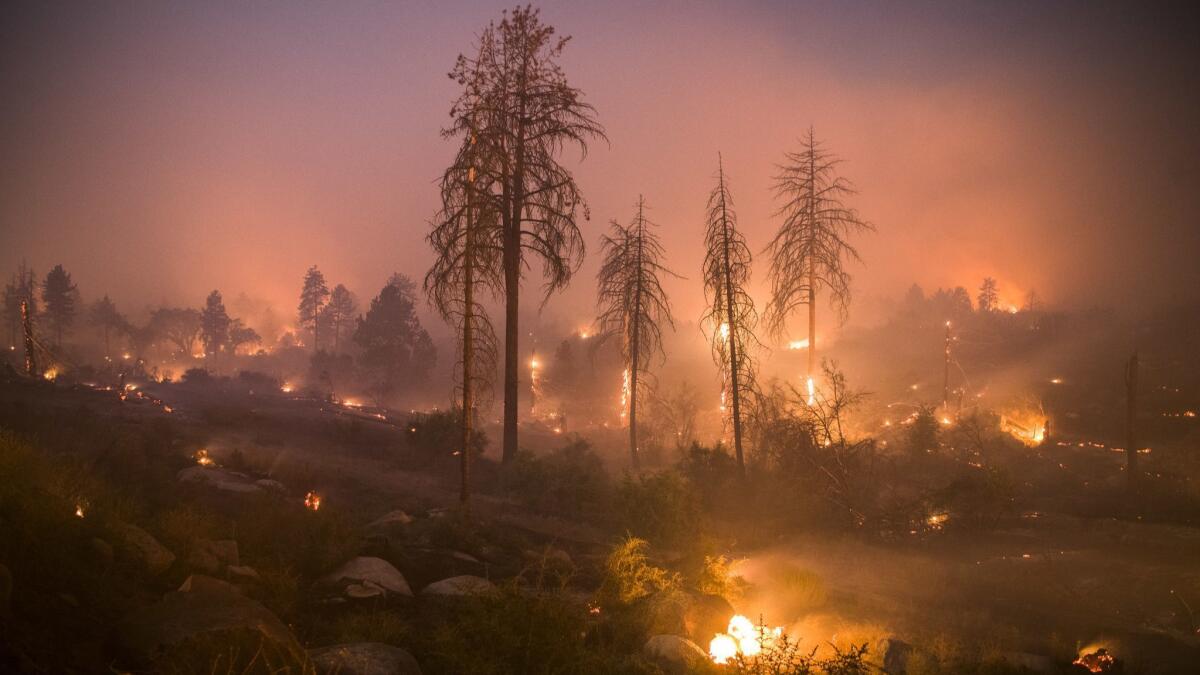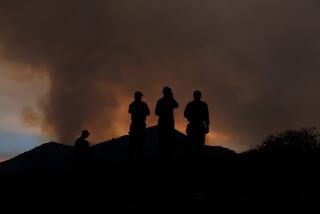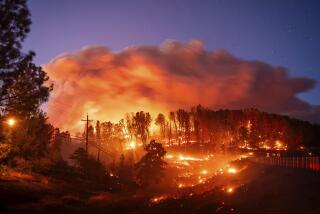5 homes destroyed and thousands evacuated in suspected arson near Idyllwild

- Share via
Reporting from MOUNTAIN CENTER, CALIF. — A suspected arson fire that erupted in the San Jacinto Mountains near Idyllwild continued to spread Thursday as a second, smaller fire ignited just miles away and required the diversion of some firefighting resources.
The Cranston fire was deliberately set, authorities say, by a 32-year-old Temecula man Wednesday afternoon. The fire has destroyed five homes and caused thousands to flee. Chewing through grass and brush that have been baked dry by a heat wave, the wildfire has scorched 4,700 acres and is only 5% contained.
A towering pyrocumulus cloud has formed over the fire area, which will probably cause significant challenges for firefighters, said Capt. Scott Visyak of Cal Fire. Clouds from the pyrocumulus have already started collapsing onto themselves, which will cause the weather to change, Visyak said.
“Those clouds form from fire,” Visyak said. “It’s all heat, toxins and smoke.”
The Cranston fire is being fed by dry fuel on steep slopes that further challenge firefighters. The pyrocumulus will create more challenges for firefighters as winds start going in the opposite direction, he said. On Thursday afternoon, the fire was spreading down into Apple Canyon.
The first five destroyed homes burned before sundown Wednesday in Idyllwild’s Deer Foot neighborhood, Visyak said. Resources are stretched thin battling other blazes across the state, so crews are sometimes assigning one fire engine for every two homes and are having to move on from residences that are deemed too much at-risk to try and protect, he said. With that said, firefighters are trying to protect every home they can, he added.
Some residents refuse to leave the small, unincorporated town beloved by tourists for its impressive hiking trails.
Jon Millhouse and his two children sat outside the Red Kettle breakfast joint in one of the town’s main avenues Thursday morning as a large plume of smoke billowed in the sky, casting an orange shadow over the area.
He held in his hand a plastic container with a rattlesnake inside. The rattlesnakes may be coming out of their shelters because of the fire, he said, and he didn’t want firefighters getting bit.
Others in surrounding areas were left without power, like Ruth Kleefisch, who made the drive to Idyllwild from her Pine Cove home, where the power was out.
Kleefisch was desperate to power up her phone and get cell reception so she could communicate with the doctor of her husband, who has liver cancer and has been unable to eat for four days.
She said she’s more fearful of being left without power for more than a few days than she is of the fire, which hadn’t reached Pine Cove on Thursday afternoon.
“The neighborhood’s quiet, everything is quiet,” she said. “There’s nobody here. Once all the tourists leave, there’s not that many left of us, really.”
On Thursday afternoon, a smaller fire broke out about 10 to 12 miles east of the Cranston fire. The Ribbonwood fire started right near Route 74 and Ribbonwood Drive around 11:30 a.m. and spread to roughly 65 acres by 1 p.m.
For some residents, it was a night of wondering if their homes were still standing.
Steve Coffer was having lunch in Mountain Center at noon Wednesday when he saw the fire. He walked out of Mountain Center Cafe and said to his wife, Suzanne, “We’re going home, honey.”
The couple hurried back to pack their cars and grab their cat, Kit Kat. Before leaving, Steve Coffer walked down Deer Foot Lane to a ledge where he saw flames building throughout the large canyon behind the neighborhood.
Looking down, he realized the fire had made its way through a fire break. That’s when he decided it was time to go. The Coffers, cat in tow, slept at the Catholic church in Idyllwild on Wednesday night.
Coffer, a 40-year resident of Idyllwild, moved to the small town because he wanted to live in the mountains after growing up in San Diego.
Together, he and his wife have built a home complete with a garden, some of which they willingly “donate” to the wildlife. On Thursday afternoon, that home and garden were covered in pink fire retardant.
Nearby, a few neighbors lost their homes. Coffer was less concerned about how he would remove all of the retardant and more interested in praising the firefighters, including the air assault team, which he said arrived substantially faster than in any previous fire, including the Mountain fire in 2013.
The Coffers came back to their home at 6 a.m. to find it covered in retardant but safe. “It’s what you make of things,” Coffer said.
For fire crews, there’s no escaping battling the fire in the punishing summer heat.
On Thursday, the National Weather Service announced it was extending an excessive heat advisory from Thursday evening to Friday evening.
The weather pattern has intermittently knocked out power to thousands of customers in Los Angeles County and elsewhere as customers ratchet up their air conditioners and utility equipment overheats.
But where the heat isn’t challenging the electrical grid, it’s priming the landscape for fire.
Along the Central Sierra in Mariposa County, thousands of firefighters are trying to get a handle on the Ferguson fire outside Yosemite National Park. The blaze has scorched 43,299 acres since it began July 13 south of Highway 140.
That blaze has killed one firefighter and injured seven more. It was 27% contained as of Thursday morning, but continued to pose challenges as it burned through rugged mountain terrain. U.S. Forest Service officials said the blaze jumped a containment line overnight and made a push south that crews are working to contain.
The fire continues to keep a host of isolated mountain communities under evacuation orders, including El Portal, Anderson Valley and Yosemite West.
Farther north, firefighters are also battling against the Carr fire in Shasta County. That 20,000-acre blaze began Monday and began burning homes Wednesday night, according to Cal Fire officials. The Carr fire was 10% contained Thursday.
Altogether, there are more than a dozen wildfires burning across California as of Thursday morning, according to Cal Fire.
The blaze that’s the most immediate threat to Southern Californians, however, continues to be the Cranston fire. The fire was listed as only 5% contained Thursday morning and was still listed at 4,700 acres.
Authorities have closed Highway 73 from Hemet to Lake Hemet and Highway 243 from Banning to Highway 74. The South Coast Air Quality Management District issued a smoke advisory Thursday for Riverside County and the San Bernardino National Forest.
Twitter: @JosephSerna
UPDATES:
3:15 p.m.: This post was updated with more scenes of residents.
2:15 p.m.: This article was updated with comments from Visyak, Kleefisch and Millhouse.
This article was originally published at 12:20 p.m.
More to Read
Sign up for Essential California
The most important California stories and recommendations in your inbox every morning.
You may occasionally receive promotional content from the Los Angeles Times.













